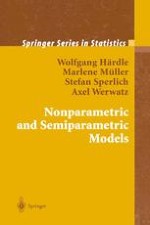2004 | OriginalPaper | Chapter
Additive Models and Marginal Effects
Authors : Wolfgang Härdle, Axel Werwatz, Marlene Müller, Stefan Sperlich
Published in: Nonparametric and Semiparametric Models
Publisher: Springer Berlin Heidelberg
Included in: Professional Book Archive
Activate our intelligent search to find suitable subject content or patents.
Select sections of text to find matching patents with Artificial Intelligence. powered by
Select sections of text to find additional relevant content using AI-assisted search. powered by
Additive models have been proven to be very useful as they naturally generalize the linear regression model and allow for an interpretation of marginal changes, i.e. for the effect of one variable on the mean function m(●) when holding all others constant. This kind of model structure is widely used in both theoretical economics and in econometric data analysis. The standard text of Deaton & Muellbauer (1980) provides many examples in microeconomics for which the additive structure provides interpretability. In econometrics, additive structures have a desirable statistical form and yield many well known economic results. For instance, an additive structure allows us to aggregate inputs into indices; elasticities or rates of substitutions can be derived directly. The separability of the input parameters is consistent with decentralization in decision making or optimization by stages. In summary, additive models can easily be interpreted.
